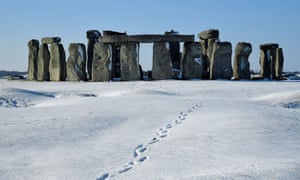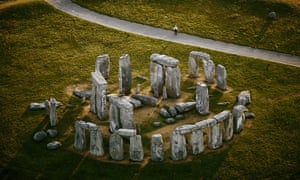Mega lift? Stonehenge pillars were carried 230km over land – research

Discovery of two monolith quarries undermine theory that the bluestone pillars of Stonehenge were taken from Wales to Wiltshire by sea, researchers say. Photograph: Toby Melville/Reuters
Archaeologists say up to 80 two-ton blocks may have been dragged from Preseli hills
Esther Addley
They are among the most famous and most enigmatic mysteries in all of archaeology: how did neolithic builders, using only stone, wooden and bone tools, carve Stonehenge’s bluestone pillars from the hilltops of western Wales – and how on earth did they transport them more than 230km (143 miles) to Salisbury plain?
Now, an excavation has found intriguing new evidence of the method by which the huge stones were chiselled out of the rock face at two craggy outcrops of the Preseli hills in Pembrokeshire.
The location of the two monolith quarries, according to the archaeologists, undermines the theory that the stones were taken to Wiltshire by sea, instead suggesting the two-ton blocks, up to 80 in number, were dragged or carried over land.
The archaeologists’ research also supports the tantalising possibility, they say, that the bluestones – thought to date from the very first phase of construction at Stonehenge – may have first been used in a stone circle in Wales, before that monument was dismantled and transported hundreds of kilometres south-east, for reasons which remain a mystery.
Prof Mike Parker Pearson of University College London, who led the excavation, said: “What’s really exciting about these discoveries is that they take us a step closer to unlocking Stonehenge’s greatest mystery – why its stones came from so far away.
“Every other neolithic monument in Europe was built of megaliths brought from no more than 10 miles [16km] away. We’re now looking to find out just what was so special about the Preseli hills 5,000 years ago, and whether there were any important stone circles here, built before the bluestones were moved to Stonehenge.”
Stonehenge’s bluestones are not the enormous sarsen trilithons for which it is most famous, but a separate set of stones which now stand inside the sarsen ring but which, it is thought, may once have formed a much larger circle when the monument was first built, about 3,000BC.
Though smaller than the sarsens – and often overlooked by visitors as a result – they are still about two metres in height and would each have weighed about the same as a car, according to Dr Rob Ixer, one of the report’s co-authors.
The new excavation focused on a crag called Carn Goedog, where the spotted dolerite rock naturally forms into pillar-shaped slabs. Parker Pearson and his team were able to identify recesses in the rock face from which pillars were quarried, carbon-dating charcoal found between the slabs to the fourth millennium BC.
They also discovered a number of distinctively wedge-shaped stone tools, formed from imported mudstone or sandstone, which they believe were hammered between the slabs in order to prise them apart, and identified V-shaped gaps between the pillars that they think were cut into the rock to let the wedge in. Their research is published in the journal Antiquity.

Stonehenge, near Salisbury and Amesbury, Wiltshire, England. Photograph: Yann Arthus-Bertrand/Getty Images
Excavation has also uncovered an artificial platform at the base of the outcrop, laid with stones. Prof Colin Richards, who has excavated Britain’s only other identified megalith quarry in the Orkney islands, said: “Bluestone pillars could be eased down on to this platform, which acted as a loading bay for lowering them on to wooden sledges before dragging them away.”
A ditch dug next to the platform suggests the quarry may have been “decommissioned” soon after the bluestones were removed, for reasons unknown.
The bluestones were previously thought to originate from the southern Preseli hills, but the location of Carn Goedog and the other confirmed quarry on the northern slopes of the range “completely changes” the assumptions of how the stones were transported to Wiltshire, Ixer told the Guardian.
He said: “The idea was that they were dragged down the southern slopes to Milford Haven, and then transported by raft along the Severn estuary and along the River Avon to Salisbury plain. Instead we now believe, and it seems pretty likely, that the stones were all manually transported”.He believes the route taken roughly follows the modern A40.
Ixer said: “there is enough room in the carbon-14 dates [of the quarries and of the earliest phase of Stonehenge] to perhaps say, ‘Were the stones erected as a circle in Wales before they were erected as a circle in Stonehenge?’ The end of this paper suggests that it would be worth looking at some of the stone circles on the Preseli hills to see if they once held the Stonehenge bluestones.”
Even if that were found, however, the question of why they were transported can never fully be answered, he said. “We will never understand Stonehenge. That is the beauty of the monument.”
No comments:
Post a Comment